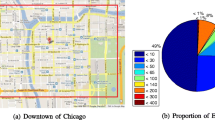Abstract
A smart city’s main purpose is to provide intelligent responses to different problems of the rapid urban population growth. For instance, integrating fleet management solutions into intelligent transportation systems (ITS) can efficiently resolve transportation problems relying on each vehicle information. Usually, the position estimate is ensured by the integration of the Global Positioning System (GPS) and Inertial Navigation Systems (INS). For multisensor data fusion, the Extended Kalman Filter (EKF) is generally applied using the sensor’s measures and the GPS position as a helper. However, the INS are expensive and require more complex computing which induces restrictions on their implementation. Furthermore, the EKF performance depends on the vehicle dynamic variations and may quickly diverge because of environmental changes. In this paper, we present a robust low cost approach using EKF and Support Vector Machines (SVM) to reliably estimate the vehicle position by limiting the EKF drawbacks. The sensors used are a GPS augmented by a low cost wireless sensor network. When GPS signals are available, we train SVM on different dynamics and outage times to learn the position errors so we can correct the future EKF predictions during GPS signal outages. We obtain empirically an improvement of up to 94% over the simple EKF predictions in case of GPS failures.











Similar content being viewed by others
References
Xiong Z, Sheng H, Rong W, Cooper DE (2012) Intelligent transportation systems for smart cities: a progress review. Sci Chin Inf Sci 55:2908–2914. doi:10.1007/s11432-012-4725-1
El Faouzi NE, Klein LA (2016) Data fusion for ITS: techniques and research needs. Transp Res Proced 15:495–512. doi:10.1016/j.trpro.2016.06.042
De Ponte Müller F (2017) Survey on ranging sensors and cooperative techniques for relative positioning of vehicles. Sensors 17:1–27. doi:10.3390/s17020271
Grewal MS (2011) Kalman filtering. Int Encyclop Statist Sci 1:705–708. doi:10.1007/978-3-642-04898-2_321
Niu X, Ban Y, Zhang Q, Zhang T, Zhang H, Liu J (2015) Quantitative analysis to the impacts of IMU quality in GPS/INS deep integration. Micromachines 6:1082–1099. doi:10.3390/mi6081082
Zhang H, Zhao Y (2011) The performance comparison and analysis of extended Kalman filters for GPS/DR navigation. Optik - Int J Light Electron Opt 122:777–781. doi:10.1016/j.ijleo.2010.05.023
Shen Z, Georgy J, Korenberg M J, Noureldin A (2011) Low cost two dimension navigation using an augmented Kalman filter/ fast orthogonal search module for the integration of reduced inertial sensor system and global positioning system. Trans Res Part C: Emerg Technol 19:1111–1132. doi:10.1016/j.trc.2011.01.001
Tamazin M, Noureldin A, Korenberg MJ, Kamel AM (2016) A new high-resolution GPS multipath mitigation technique using fast orthogonal search. J Navig 69:794–814. doi:10.1017/s0373463315001022
Abd Rabbou M, El-Rabbany A (2015) Integration of GPS precise point positioning and MEMS-based INS using unscented particle filter. Sensors 15:7228–7245. doi:10.3390/s150407228
Zhao Y (2014) An improved unscented particle filter with global sampling strategy. J Comput Eng :1–6. doi:10.1155/2014/175820
Noureldin A, El-Shafie A, Bayoumi M (2011) GPS/INS Integration utilizing dynamic neural networks for vehicular navigation. Inf Fus 12:48–57. doi:10.1016/j.inffus.2010.01.003
Li Z, Wang J, Li B, Gao J, Tan X (2014) GPS/INS/odometer integrated system using fuzzy neural network for land vehicle navigation applications. J Navig 67:967–983. doi:10.1017/S0373463314000307
Belhajem I, Ben Maissa Y, Tamtaoui A (2017) An improved robust low cost approach for real time vehicle positioning in a smart city. Ind Netw Intell Syst :77–89. doi:10.1007/978-3-319-52569-3_7
Belhajem I, Ben Maissa Y, Tamtaoui A (2017) A hybrid machine learning based low cost approach for real time vehicle position estimation in a smart city. Adv Ubiq Network 2:559–572. doi:10.1007/978-981-10-1627-1_44
Adusumilli S, Bhatt D, Wang H, Devabhaktuni V, Bhattacharya P (2015) A novel hybrid approach utilizing principal component regression and random forest regression to bridge the period of GPS outages. Neurocomputing 166:185–192. doi:10.1016/j.neucom.2015.03.080
Bhatt D, Aggarwal P, Devabhaktuni V, Bhattacharya P (2014) A novel hybrid fusion algorithm to bridge the period of GPS outages using low-cost INS. Expert Syst Appl 41:2166–2173. doi:10.1016/j.eswa.2013.09.015
Chen Q, Whitbrooka A, Aickelina U, Roadknight C (2014) Data classification using the Dempster-Shafer method. J Exper Theor Artif Intell 26:493–517. doi:10.1080/0952813X.2014.886301
Lucet E, Betaille D, Donnay Fleury N, Ortiz M, SALLE D, Canou J (2009) Real-time 2D localization of a car-like mobile robot using dead reckoning and GPS, with satellite masking prediction. Accur Local Land Transp Workshop :15–18
Cortes C, Vapnik V (1995) Support-vector networks. Mach Learn 20:273–297. doi:10.1023/A:1022627411411
Shawe-Taylor J, Cristianini N (2004) Pattern analysis using convex optimisation. Kernel Methods Pattern Anal. 1:195–251. doi:10.1017/CBO9780511809682.008
Hsu CW, Chang CC, Lin CJ (2010) A practical guide to support vector classification. Dissertation, National Taiwan University
Basak D, Pal S, Patranabis DC (2007) Support vector regression. Neural Inf Process Lett Rev 11:203–224
Smola AJ, Schölkopf B (2004) A tutorial on support vector regression. Stat Comput 14:199–222. doi:10.1023/B:STCO.0000035301.49549.88
Breiman L (2001) Random forests. Mach Learn 45:5–32. doi:10.1023/A:1010933404324
Liaw A, Wiener M (2002) Random forests. R News 2:18–22. doi:10.7717/peerj.703/table-4
Korrapati H, Courbon J, Alizon S, Marmoiton F (2013) The institut pascal data set”: un jeu de données en extérieur, multicapteurs et datées avec réalité terrain, données d’étalonnage et outils logiciels. ORASIS, Congrès des jeunes chercheurs en vision par ordinateur 1–8
Goodall C (2009) Improving usability of low-cost INS/GPS navigation systems using intelligent techniques. Dissertation, University of Calgary
Acknowledgments
This work was financially supported by the National Center of Scientific and Technical Research (CNRST), Morocco.
Author information
Authors and Affiliations
Corresponding author
Rights and permissions
About this article
Cite this article
Belhajem, I., Maissa, Y.B. & Tamtaoui, A. Improving Vehicle Localization in a Smart City with Low Cost Sensor Networks and Support Vector Machines. Mobile Netw Appl 23, 854–863 (2018). https://doi.org/10.1007/s11036-017-0879-9
Published:
Issue Date:
DOI: https://doi.org/10.1007/s11036-017-0879-9




